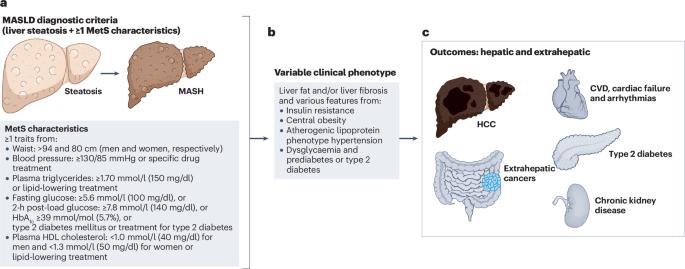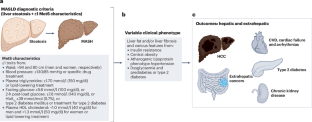Μetabolic dysfunction-associated steatotic liver disease: a condition of heterogeneous metabolic risk factors, mechanisms and comorbidities requiring holistic treatment
IF 51
1区 医学
Q1 GASTROENTEROLOGY & HEPATOLOGY
引用次数: 0
Abstract
Μetabolic dysfunction-associated steatotic liver disease (MASLD) comprises a heterogeneous condition in the presence of steatotic liver. There can be a hierarchy of metabolic risk factors contributing to the severity of metabolic dysfunction and, thereby, the associated risk of both liver and extrahepatic outcomes, but the precise ranking and combination of metabolic syndrome (MetS) traits that convey the highest risk of major adverse liver outcomes and extrahepatic disease complications remains uncertain. Insulin resistance, low-grade inflammation, atherogenic dyslipidaemia and hypertension are key to the mechanisms of liver and extrahepatic complications. The liver is pivotal in MetS progression as it regulates lipoprotein metabolism and secretes substances that affect insulin sensitivity and inflammation. MASLD affects the kidneys, heart and the vascular system, contributing to hypertension and oxidative stress. To address the global health burden of MASLD, intensified by obesity and type 2 diabetes mellitus epidemics, a holistic, multidisciplinary approach is essential. This approach should focus on both liver disease management and cardiometabolic risk factors. This Review examines the link between metabolic dysfunction and liver dysfunction and extrahepatic disease outcomes, the diverse mechanisms in MASLD due to metabolic dysfunction, and a comprehensive, personalized management model for patients with MASLD. This Review discusses the link between metabolic dysfunction-associated steatotic liver disease (MASLD) — a heterogeneous health condition — and hepatic and extrahepatic disease manifestations and provides a comprehensive platform for personalized, holistic management for patients with MASLD.


Μetabolic功能障碍相关的脂肪变性肝病:异质性代谢危险因素、机制和需要整体治疗的合并症
Μetabolic功能障碍相关脂肪变性肝病(MASLD)包括存在脂肪变性肝的异质状况。代谢危险因素可能会导致代谢功能障碍的严重程度,从而导致肝脏和肝外预后的相关风险,但代谢综合征(MetS)特征的精确排名和组合仍然不确定,这些特征传达了主要不良肝脏预后和肝外疾病并发症的最高风险。胰岛素抵抗、低度炎症、动脉粥样硬化性血脂异常和高血压是肝脏和肝外并发症的关键机制。肝脏调节脂蛋白代谢,分泌影响胰岛素敏感性和炎症的物质,在代谢过程中起关键作用。MASLD影响肾脏、心脏和血管系统,导致高血压和氧化应激。为了解决因肥胖和2型糖尿病流行而加剧的MASLD的全球健康负担,必须采取综合、多学科的办法。这种方法应该同时关注肝脏疾病管理和心脏代谢危险因素。这篇综述探讨了代谢功能障碍、肝功能障碍和肝外疾病结局之间的联系,代谢功能障碍导致MASLD的多种机制,以及MASLD患者的综合、个性化管理模式。
本文章由计算机程序翻译,如有差异,请以英文原文为准。
求助全文
约1分钟内获得全文
求助全文
来源期刊
CiteScore
52.30
自引率
0.60%
发文量
147
审稿时长
6-12 weeks
期刊介绍:
Nature Reviews Gastroenterology & Hepatology aims to serve as the leading resource for Reviews and commentaries within the scientific and medical communities it caters to. The journal strives to maintain authority, accessibility, and clarity in its published articles, which are complemented by easily understandable figures, tables, and other display items. Dedicated to providing exceptional service to authors, referees, and readers, the editorial team works diligently to maximize the usefulness and impact of each publication.
The journal encompasses a wide range of content types, including Research Highlights, News & Views, Comments, Reviews, Perspectives, and Consensus Statements, all pertinent to gastroenterologists and hepatologists. With its broad scope, Nature Reviews Gastroenterology & Hepatology ensures that its articles reach a diverse audience, aiming for the widest possible dissemination of valuable information.
Nature Reviews Gastroenterology & Hepatology is part of the Nature Reviews portfolio of journals.

 求助内容:
求助内容: 应助结果提醒方式:
应助结果提醒方式:


